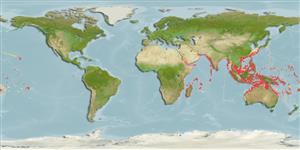Common names from other countries
>
Eupercaria/misc (Various families in series Eupercaria) >
Lutjanidae (Snappers) > Lutjaninae
Etymology: Lutjanus: Malay, ikan lutjan, name of a fish.
More on author: Cuvier.
Environment: milieu / climate zone / depth range / distribution range
Ecologia
marino associati a barriera corallina; distribuzione batimetrica 50 - 100 m (Ref. 9710). Tropical; 35°N - 31°S, 31°E - 145°W (Ref. 55)
Indo-Pacific: East Africa to Tahiti, north to southern Japan, south to Australia.
Length at first maturity / Size / Peso / Age
Maturity: Lm ?, range 37 - ? cm
Max length : 80.0 cm TL maschio/sesso non determinato; (Ref. 11441); common length : 60.0 cm TL maschio/sesso non determinato; (Ref. 5450); peso massimo pubblicato: 11.0 kg (Ref. 9710)
Spine dorsali (totale): 10; Raggi dorsali molli (totale): 15-16; Spine anali 3; Raggi anali molli: 8. This species is distinguished by the following characters: body very deep, greatest depth 2.1-2.4 in SL; lips greatly thickened in adults; preopercular notch and knob moderately developed; vomerine tooth patch crescentic, without a medial posterior extension; tongue smooth, no teeth; gill rakers of first gill arch 6 + 11-12 =17-18; caudal fin truncate or slightly emarginate. Colour generally brown with a reddish tinge; each scale on side with a pale
brown border and 2-3 small bluish white spots in central portion; head with numerous undulating blue lines; lips tan; fins largely yellowish to dusky grey-brown; juveniles with a series of 3-8 brown bars on sides and a chalky white spot, with a broad blackish margin, present below anterior soft dorsal-fin rays at level of lateral line, preceded by similar-sized black spot on middle of side (Ref. 9821, 90102).
Occasionally encountered in coral reefs or shallow inshore flats (Ref. 30573). Found singly or in small groups (up to 15 to 20 individuals). Adults on deep coastal slopes; juveniles on shallow algae-reef flats, often near freshwater run-offs (Ref. 48635). Feed on fishes, cephalopods and benthic crustaceans (Ref. 30573). An excellent food fish. In Hong Kong live fish markets (Ref. 27253). Caught with handlines, traps, and gill nets, occasionally trawled; important to artisanal fisheries and marketed mostly fresh (Ref. 9821). Minimum depth reported taken from Ref. 57178.
Life cycle and mating behavior
Maturità | Riproduzione | Deposizione | Uova | Fecundity | Larve
Allen, G.R., 1985. FAO Species Catalogue. Vol. 6. Snappers of the world. An annotated and illustrated catalogue of lutjanid species known to date. FAO Fish. Synop. 125(6):208 p. Rome: FAO. (Ref. 55)
IUCN Red List Status (Ref. 130435)
CITES (Ref. 128078)
Not Evaluated
Threat to humans
Reports of ciguatera poisoning (Ref. 30298)
Human uses
Pesca: commerciale; Acquacoltura: commerciale; Pesce da pesca sportiva: si
Informazioni ulteriori
BibliografiaAcquacolturaProfilo di acquacolturaVarietàGeneticaElectrophoresesEreditarietàMalattieElaborazioneMass conversion
Strumenti
Special reports
Download XML
Fonti Internet
Estimates based on models
Preferred temperature (Ref.
115969): 22.5 - 28.2, mean 26.5 (based on 353 cells).
Phylogenetic diversity index (Ref.
82804): PD
50 = 0.5000 [Uniqueness, from 0.5 = low to 2.0 = high].
Bayesian length-weight: a=0.01549 (0.00881 - 0.02723), b=3.02 (2.88 - 3.16), in cm Total Length, based on LWR estimates for this species & Genus-body shape (Ref.
93245).
Trophic level (Ref.
69278): 4.1 ±0.63 se; based on food items.
Resilienza (Ref.
120179): Medio, tempo minimo di raddoppiamento della popolazione 1.4 - 4.4 anni (K=0.22).
Fishing Vulnerability (Ref.
59153): High vulnerability (62 of 100).
